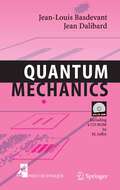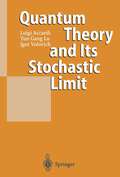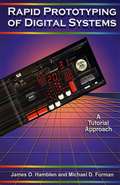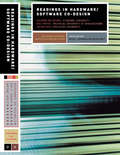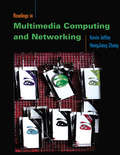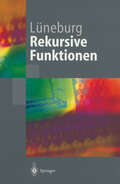- Table View
- List View
Quantum Mechanics
by Jean-Louis Basdevant Jean DalibardGives a fresh and modern approach to the field. It is a textbook on the principles of the theory, its mathematical framework and its first applications. It constantly refers to modern and practical developments, tunneling microscopy, quantum information, Bell inequalities, quantum cryptography, Bose-Einstein condensation and quantum astrophysics. The book also contains 92 exercises with their solutions.
Quantum Mechanics, Mathematics, Cognition and Action: Proposals for a Formalized Epistemology (Fundamental Theories of Physics #129)
by Mioara Mugur-Schächter Alwyn Van Der MerweQuantum Theory and Its Stochastic Limit
by Luigi Accardi Yun Gang Lu Igor VolovichWell suited as a textbook in the emerging field of stochastic limit, which is a new mathematical technique developed for solving nonlinear problems in quantum theory.
Quantum (Un)speakables: From Bell to Quantum Information
by R. A. Bertlmann A. ZeilingerThis outstanding collection of essays leads the reader from the foundations of quantum mechanics to quantum entanglement, quantum cryptography, and quantum information, and is written for all those in need of a thorough insight into this new area of physics.
Randomization and Approximation Techniques in Computer Science: 6th International Workshop, RANDOM 2002, Cambridge, MA, USA, September 13-15, 2002, Proceedings (Lecture Notes in Computer Science #2483)
by José D. P. Rolim Salil VadhanRapid Prototyping of Digital Systems
by James O. Hamblen Michael D. FurmanRapid Prototyping of Digital Systems provides an exciting and challenging laboratory component for undergraduate digital logic and computer design courses. The more advanced topics and exercises also make this text useful for upper level courses in digital logic or programmable logic. Design engineers working in industry will want to consider this text for a rapid introduction to PPLD technology and logic synthesis using commercial CAD tools. Rapid Prototyping of Digital Systems includes two tutorials on the Altera CAD tool environment, an overview of programmable logic, and a design library with several easy-to-use input and output functions. These features were developed to help students get started quickly. Early design examples use schematic capture and library components. VHDL is used for more complex designs after a short introduction to VHDL-based synthesis. The approach used in this text reflects contemporary practice in industry more accurately than the more traditional TTL protoboard-based laboratory courses. Designs containing up to twenty thousand gates are possible with the Altera Student Version CAD tools and the UP 1 board. Rapid Prototyping of Digital Systems contains a number of interesting and challenging laboratory projects involving serial communications, state machines with video output, video games and graphics, simple computers, keyboard and mouse interfaces, robotics, and a RISC processor core. These projects were all developed on the student version of the Altera CAD tools and can be implemented on the Altera UP 1 board.
Readings in Hardware/Software Co-Design (ISSN)
by Giovanni De Micheli Rolf Ernst Wayne WolfEmbedded system designers are constantly looking for new tools and techniques to help satisfy the exploding demand for consumer information appliances and specialized industrial products. One critical barrier to the timely release of embedded system products is integrating the design of the hardware and software systems. Hardware/software co-design is a set of methodologies and techniques specifically created to support the concurrent design of both systems, effectively reducing multiple iterations and major redesigns. In addition to its critical role in the development of embedded systems, many experts believe that co-design will be a key design methodology for Systems-on-a-Chip.Readings in Hardware/Software Co-Design presents the papers that have shaped the hardware/software co-design field since its inception in the early 90s. Field experts -- Giovanni De Micheli, Rolf Ernst, and Wayne Wolf -- introduce sections of the book, and provide context for the paper that follow. This collection provides professionals, researchers and graduate students with a single reference source for this critical aspect of computing design.* Over 50 peer-reviewed papers written from leading researchers and designers in the field* Selected, edited, and introduced by three of the fields' most eminent researchers and educators* Accompanied by an annually updated companion Web site with links and references to recently published papers, providing a forum for the editors to comment on how recent work continues or breaks with previous work in the field
Readings in Multimedia Computing and Networking (The Morgan Kaufmann Series in Multimedia Information and Systems)
by Kevin Jeffay Hong Jiang ZhangReadings in Multimedia Computing and Networking captures the broad areas of research and developments in this burgeoning field, distills the key findings, and makes them accessible to professionals, researchers, and students alike. For the first time, the most influential and innovative papers on these topics are presented in a cohesive form, giving shape to the diverse area of multimedia computing. The seminal moments are recorded by a dozen visionaries in the field and each contributing editor provides a context for their area of research by way of a thoughtful, focused chapter introduction. The volume editors, Kevin Jeffay and HongJiang Zhang, offer further incisive interpretations of past and present developments in this area, including those within media and content processing, operating systems, and networking support for multimedia. This book will provide you with a sound understanding of the theoretical and practical issues at work in the field's continuing evolution.* Offers an in-depth look at the technical challenges in multimedia and provides real and potential solutions that promise to expand the role of multimedia in business, entertainment, and education.* Examines in Part One issues at the heart of multimedia processes: the means by which multimedia data are coded, compressed, indexed, retrieved, and otherwise manipulated.* Examines in Part Two the accommodation of these processes by storage systems, operating systems, network protocols, and applications.* Written by leading researchers, the introductions give shape to a field that is continually defining itself and place the key research findings in context to those who need to understand the state-of-the art developments.
Real-time 3D Character Animation with Visual C++
by Nik LeverDo you have some experience and a reasonable knowledge of C++ and want to write your own computer games? Have you ever looked at a PC or Playstation (R) game with characters running and leaping through an exciting landscape and wondered how it was done? If so then this book will give you all the information you need to achieve this goal, whether you are a hobby programmer, student or even a professional wanting to add that third dimension to your website.Nik Lever takes you through the journey from the basics of 3D manipulation all the way to morph objects and sub-division surfaces. On the way you get Visual C++ project files to study and software that runs on the Windows desktop. The free CD-ROM gives you a full-featured development environment for 3D character animation, so even if you find some of the maths and the code hard to follow straight away you can still create your own games. The game engine (Toon3DCreator) provided free and fully functional on the CD-ROM, even has an ActiveX control that allows you to distribute your work on the Internet. All source code for Toon3D is included on the CD. You will also get an insight into the artist's problems; learn how to keep the characters interesting while not exhausting the game engine. Understand the complete picture and make the most of your skills to help you succeed in, or break into the computer gaming industry with this comprehensive guide to programming for real-time 3D character animation.
Real-time 3D Character Animation with Visual C++
by Nik LeverDo you have some experience and a reasonable knowledge of C++ and want to write your own computer games? Have you ever looked at a PC or Playstation (R) game with characters running and leaping through an exciting landscape and wondered how it was done? If so then this book will give you all the information you need to achieve this goal, whether you are a hobby programmer, student or even a professional wanting to add that third dimension to your website.Nik Lever takes you through the journey from the basics of 3D manipulation all the way to morph objects and sub-division surfaces. On the way you get Visual C++ project files to study and software that runs on the Windows desktop. The free CD-ROM gives you a full-featured development environment for 3D character animation, so even if you find some of the maths and the code hard to follow straight away you can still create your own games. The game engine (Toon3DCreator) provided free and fully functional on the CD-ROM, even has an ActiveX control that allows you to distribute your work on the Internet. All source code for Toon3D is included on the CD. You will also get an insight into the artist's problems; learn how to keep the characters interesting while not exhausting the game engine. Understand the complete picture and make the most of your skills to help you succeed in, or break into the computer gaming industry with this comprehensive guide to programming for real-time 3D character animation.
Real-Time Database Systems: Architecture and Techniques (The Springer International Series in Engineering and Computer Science #593)
by Kam-Yiu Lam Tei-Wei KuoIn recent years, tremendous research has been devoted to the design of database systems for real-time applications, called real-time database systems (RTDBS), where transactions are associated with deadlines on their completion times, and some of the data objects in the database are associated with temporal constraints on their validity. Examples of important applications of RTDBS include stock trading systems, navigation systems and computer integrated manufacturing. Different transaction scheduling algorithms and concurrency control protocols have been proposed to satisfy transaction timing data temporal constraints. Other design issues important to the performance of a RTDBS are buffer management, index accesses and I/O scheduling. Real-Time Database Systems: Architecture and Techniques summarizes important research results in this area, and serves as an excellent reference for practitioners, researchers and educators of real-time systems and database systems.
Real-Time Shading
by Marc Olano John Hart Wolfgang Heidrich Michael McCoolThis book covers real-time shading systems, their design and how they work. Procedural shading, long valued for off-line rendering and production animation is now possible on interactive graphics hardware. These developments are important for areas such as game development, product design, and scientific visualization, among others. The authors inc
Real-Time Systems: Scheduling, Analysis, and Verification
by Albert M. ChengThe first book to provide a comprehensive overview of the subject rather than a collection of papers. The author is a recognized authority in the field as well as an outstanding teacher lauded for his ability to convey these concepts clearly to many different audiences. A handy reference for practitioners in the field.
Real World ASP.NET: Building a Content Management System
by Stephen R.G. FraserThis is the complete hands-on guide to mastering the art of Content Management Systems (CMS) and Web site development using the .NET Framework.
Recent Advances in Intrusion Detection: 5th International Symposium, RAID 2002, Zurich, Switzerland, October 16-18, 2002, Proceedings (Lecture Notes in Computer Science #2516)
by Andreas Wespi Giovanni Vigna Luca Deri
Recent Advances in Parallel Virtual Machine and Message Passing Interface: 9th European PVM/MPI User's Group Meeting Linz, Austria, September 29 - October 2, 2002, Proceedings (Lecture Notes in Computer Science #2474)
by Dieter Kranzlmüller Peter Kacsuk Jack Dongarra Jens VolkertThis book constitutes the refereed proceedings of the 9th European PVM/MPI Users'Group Meeting held in Linz, Austria in September/October 2002.The 50 revised full papers presented together with abstracts of 11 invited contributions were carefully reviewed and selected. The papers are organized in topical sections on Corss Grid, Par Sim, application using MPI and PVM, parallel algorithms using message passing, programming tools for MPI and PVM, implementations of MPI and PVM, extensions of MPI and PVM, and performance analysis and optimization.
Recent Advances in Statistical Research and Data Analysis
by Y. Baba A. J. Hayter K. Kanefuji S. KurikiRecent Advances in Statistical Research and Data Analysis is a collection of papers presented at the symposium of the same name, held in Tokyo by the Center for Information on Statistical Science of the Institute of Statistical Mathematics (ISM). Under the auspices of the Ministry of Education, Culture, Sports, Science and Technology of Japan, the ISM has created visiting professorships and organized symposia to promote collaboration between researchers from Japan and those from other countries. At the symposium on recent advances in statistical research and data analysis, the keynote speaker was Visiting Professor Anthony J. Hayter. This book includes Prof. Hayter's address as well as papers from special lectures that were presented at the symposium. All the contributions are concerned with theory and methodology for real data and thus will benefit researchers, students, and others engaged in data analysis.
Recent Advances in Visual Information Systems: 5th International Conference, VISUAL 2002 Hsin Chu, Taiwan, March 11-13, 2002. Proceedings (Lecture Notes in Computer Science #2314)
by Shi-Kuo Chang Zen Chen Suh-Yin LeeVisualinformationsystemsareinformationsystemsforvisualcomputing.Visual computing is computing on visual objects. Some visual objects such as images are inherently visual in the sense that their primary representation is the visual representation.Somevisualobjectssuchasdatastructuresarederivativelyvisual in the sense that their primary representation is not the visual representation, but can be transformed into a visual representation. Images and data structures are the two extremes. Other visual objects such as maps may fall somewhere in between the two. Visual computing often involves the transformation from one type of visual objects into another type of visual objects, or into the same type of visual objects, to accomplish certain objectives such as information reduction, object recognition, and so on. In visual information systems design it is also important to ask the foll- ing question: who performs the visual computing? The answer to this question determines the approach to visual computing. For instance it is possible that primarily the computer performs the visual computing and the human merely observes the results. It is also possible that primarily the human performs the visual computing and the computer plays a supporting role. Often the human and the computer are both involved as equal partners in visual computing and there are visual interactions. Formal or informal visual languages are usually needed to facilitate such visual interactions.
Recent Developments in Domain Decomposition Methods (Lecture Notes in Computational Science and Engineering #23)
by Luca F. Pavarino Andrea ToselliRecent Progress in Computational and Applied PDES: Conference Proceedings for the International Conference Held in Zhangjiajie in July 2001 (De Gruyter Expositions In Mathematics Ser. #Vol. 36)
by Tony F. Chan Yunqing Yunqing Huang Tao Tao Tang Jinchao Jinchao Xu Lung-An Lung-An YingRecent Trends in Algebraic Development Techniques: 15th International Workshop, WADT 2001, Joint with the CoFI WG Meeting, Genova, Italy, April 1-3, 2001. Selected Papers (Lecture Notes in Computer Science #2267)
by Maura Cerioli Gianna ReggioRechnerarchitektur: Aufbau, Organisation und Implementierung, inklusive 64-Bit-Technologie und Parallelrechner
by Paul HerrmannDas kompakte Lehrbuch beschreibt die hardware-technischen Merkmale moderner Rechnerarchitekturen und herstellerabhängig deren konkrete und aktuelle Implementierungen. In weiteren Kapiteln: neueste Entwicklungen auf dem Gebiet der 64 Bit-Architekturen (IA-64, Hammer, UltraSparc III, Power4), der Großrechner (Parallelrechner) und Multimedia.
Rekursive Funktionen (Springer-Lehrbuch)
by Heinz LüneburgDieses Buch basiert auf Vorlesungen, die der Autor in Kaiserslautern gehalten hat. Ihr wesentliches Anliegen war, die Turing-berechenbaren Wortfunktionen auf eine von jeglichem Maschinenmodell unabhängige Weise zu charakterisieren, nämlich als die partiell Wort-rekursiven Wortfunktionen. Wortfunktionen lassen sich mittels arithmetischer Funktionen darstellen und zwar so, dass die partiell rekursiven arithmetischen Funktionen den partiell Wort-rekursiven Wortfunktionen entsprechen, was für sich gesehen schon nicht auf der Hand liegt. Auf diese Weise erhält man den Begriff der Turing-Berechenbarkeit auch für arithmetische Funktionen. Der Satz also, dass die Turing-berechenbaren Wortfunktionen gerade die partiell rekursiven Wortfunktionen sind, ist überhaupt nicht selbstverständlich, so dass auf dem Wege zu diesem Satz eine ganze Reihe hoch interessanter weiterer Sätze zu beweisen sind. Dies alles ist hier aufgeschrieben.
Relational Methods in Computer Science: 6th International Conference, RelMiCS 2001 and 1st Workshop of COST Action 274 TARSKI Oisterwijk, The Netherlands, October 16–21, 2001 Revised Papers (Lecture Notes in Computer Science #2561)
by Harrie SwartRelationale Datenbanksysteme: Eine praktische Einführung
by Peter Kleinschmidt Christian RankDieses Buch ist eine praktische Einführung in Entwurf und Programmierung relationaler Datenbanksysteme. Es vermittelt detaillierte Kenntnisse der Datenbank-Standardsprache SQL sowie die zum Entwurf von Datenbanksystemen notwendigen theoretischen Grundlagen. Zahlreiche Beispiele und ausführliche Übungsaufgaben ermöglichen es dem Leser, schon nach kurzer Zeit eigene Datenbankapplikationen zu konzipieren. Neu in dieser Auflage ist die Integration von Datenbanken im World Wide Web, die an einem ausführlichen Beispiel erläutert wird. Das Buch ist besonders geeignet als Begleitlektüre zu Lehrveranstaltungen an Universitäten und Fachhochschulen in wirtschaftswissenschaftlichen Studiengängen oder im Studiengang Informatik. Auch Praktiker, die Datenbankkenntnisse für Applikationsentwicklungssprachen sowie Datenbank-Administrationsaufgaben benötigen, erlernen schnell das notwendige Grundwissen. Über Internet können u.a. Musterdatenbanken und Programmlistings aus dem Buch abgerufen werden.
